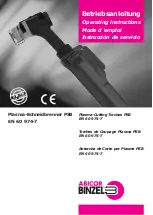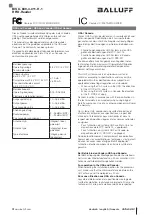
Cleanliness should be the foremost concern of a homebrewer or winemaker. Providing good
growing conditions for the yeast in the wort or must also provides good growing conditions for
other microorganisms, especially wild yeast and bacteria. Cleanliness to prevent
contamination must be maintained throughout every stage of the brewing/winemaking
process.
Winemaking – Option 2 Continued:
Days 33-40: Filtering and Bottling
Step 17:
Clean and sanitize the wine bottles
Step 18:
Rinse and sanitize the
Filling Hose
(recommended)
Step 19:
Remove the
Collection Ball
Step 20:
Attach the sanitized
Filling Hose Attachment
Step 21:
Make sure the
Hose Clamp
is closed. Then open the
Union Valve
to start filling wine
into bottles. Try to minimize the exposure to the air. Fill the bottles so that the wine
is about 0.4”(1cm) from the bottom of the cork
Step 22:
Keep wine bottles upright for 1 - 3 days
Step 23:
Store wine in a temperature controlled environment, out of direct sunlight for
suggested amount of months prior to consuming
Step 24:
Clean and sanitize all equipment
Step 25:
Get ready for your next batch using
FastFerment
!
Check to see if wine is clear - if it is not clear, it is not ready to bottle.
There is no need to remove the Collection Ball until this point. It is designed to hold
sediment with an approximate foot of clearance from the wine.
There’s a Wine Making video - www.FastBrewing.com
EN
16
Cleanliness should be the foremost concern of a homebrewer or winemaker. Providing good
growing conditions for the yeast in the wort or must also provides good growing conditions for
other microorganisms, especially wild yeast and bacteria. Cleanliness to prevent
contamination must be maintained throughout every stage of the brewing/winemaking
process.
FastFerment
7.9 Gallon (30L) Conical Fermenter
FastFerment
SS Hop Filter (
FastBrewing
accessory)
FastWasher24
Bottle Washer
FastRack24
Rack & Tray
PBW (or another cleaner)
StarSan (or another sanitizer)
Thermometer
Hydrometer
Graduated Cylinder (optional – for sampling S.G)
Bottle Brush (long handled nylon bristle brush)
Plastic Stirring Spoon (Food Grade Plastic)
Bottle Caps (check if your kit provides them)
Capper
Large Boiling pot
Wort Chiller (or ice to put in a bathtub/large sink)
0.5G (200ml) container (to prepare yeast)
Mashtun (optional)
Brew-in-a-Bag (optional)
Pen and Notepad
Homebrewing with
FastFerment
It is recommended that if you are using any
grape skins, wood chips or other flavoring items
larger than a 1/4” (0.64cm) diameter, you should
use our Hop Filter in the FastFerment
during fermentation for easy retrieval.
Suggested Equipment for Homebrewing
EN
17
Homebrewing Instructions
Please read the instructions
entirely
before starting on your brew day to ensure maximum
efficiency and the best results. We also advise you to adjust dates and measurements according
to your specific recipe. The three most important things to keep in mind every time you
brew are:
Cleanliness
,
Preparation
and
Good Record Keeping
.
Homebrewing– Option 1: Malt Extract Syrup
Day 1 - Brew Day (Follow Instructions on Ingredient Kit):
Step 1
: Clean and assemble
FastFerment
Step 2:
Perform a leak test (use water) and when successful, sanitize all equipment
Step 3:
Gather ingredients purchased from your favorite homebrew shop
Step 4:
Boil suggested amount of water
Step 5:
Once boiling, remove pot from the heat and stir in the malt extract syrup, make sure
it doesn’t collect
at the bottom (stir until completely dissolved)
Step 6:
Once dissolved, return liquid to boil for a total of 1 hour
Step 7:
Once liquid reaches a rolling boil, proceed to adding hops by following instructions
given to you (within boiling hour)
NEED EXTRA HELP? We have great resources:
Step 1: Check out our website - Go to www.FastBrewing.com
Step 2: Watch our Videos - Click on “Products” ->“Product Videos”
Step 3: Read FastFerment FAQs - Click on “FAQs” -> “FastFerment FAQs
Step 4: If you can’t find what you’re looking for, send an email to
[email protected] or call us 800 549 5763
There’s a Brewing video - www.FastBrewing.com
EN
18
Homebrewing– Option 1: Malt Extract Syrup Continued
Step 8:
Once the hour is up, it is time to chill the wort. Attach chiller to a cold-water source
and cool wort. Cool until wort has reached pitching temperature 65-90°F (18-32°C)
Step 9:
Take a sample of the wort and record a hydrometer reading
Step 10:
Re-hydrate yeast
Step 11:
Add wort into
FastFerment
and then add yeast
Fermentation:
Step 12:
Seal the lid tight and place
FastFerment
on the
Wall Mounts
or in the optional stand
accessory. Leave undisturbed for the duration of primary fermentation (time varies
depending on the type of beer)
Step 13:
Once primary fermentation is complete, close the
Union Valve
, remove and empty
the contents of the
Collection Ball
Step 14:
Sanitize and clean the
Collection Ball
before reattaching (at this point you should
also remove the mash bag if you are using one)
Step 15:
After re-attaching the
Collection Ball,
re-open the
Union Valve
Step 16:
Allow brew to sit for remainder of secondary fermentation (times vary)
Step 17:
When secondary fermentation is complete, turn off the
Union Valve
and remove the
Collection Ball
to discard the contents or harvest the yeast (See page 31)
Step 18:
Your beer is now ready to bottle!
You have the option of sealing the lid and gently shaking the conical to
aerate the wort for the yeast to grow or stir vigorously
Depending on the type of beer, choose a location that has a stable temperature.
If brewing Ale, room temperature is recommended 65-70°F (18-21°C)
There is the option to harvest the yeast for reuse. Check out page 30-31 for Tips!
There’s a Brewing video - www.FastBrewing.com
EN
19



























